Pengetahuan dan Pemanfaatan Telefarmasi dalam Memenuhi Kebutuhan Obat secara Swamedikasi pada Kelompok Usia Produktif selama Pandemi COVID-19
Downloads
Pada akhir tahun 2019 terjadi pandemi COVID-19. Pandemi ini menyebabkan masyarakat berupaya agar terhindar dari penularan virus COVID-19, salah satunya dengan membeli kebutuhan obat secara swamedikasi. Tujuan penelitian ini adalah untuk mengetahui pemanfaatan telefarmasi dalam memenuhi kebutuhan obat secara swamedikasi pada kelompok usia produktif di era pandemi COVID - 19. Penelitian yang digunakan adalah penelitian deskriptif. Responden diperoleh secara accidental sampling dengan menggunakan kuesioner online melalui google form yang disebarkan melalui media sosial. Jumlah responden yang berpartisipasi pada penelitian ini sebanyak 172 responden. Hasil penelitian menunjukkan bahwa pemanfaatan telefarmasi dalam memenuhi kebutuhan obat secara swamedikasi pada kelompok usia produktif di era pandemi COVID - 19 sebesar 24,42%. Alasan terbanyak penggunaan telefarmasi adalah kepraktisan. Sebanyak 56,98% responden tidak mengetahui bahwa terdapat apotek yang menerapkan telefarmasi. Meskipun demikian, sebanyak 86,63% responden menyatakan keberadaan telefarmasi di era pandemi merupakan suatu hal yang sangat penting dan sangat dibutuhkan. Diperlukan media promosi kesehatan yang tepat untuk masyarakat mengenai pemanfaatan telefarmasi dalam memenuhi kebutuhan obat secara swamedikasi pada usia produktif di era pandemi COVID - 19
Ameri, A., Salmanizadeh, F., and Bahaadinbeigy, K. (2020) "Tele-pharmacy: A new opportunity for consultation during the COVID-19 pandemic.', Health Policy and Technology, 9(3), hal. 281–282. doi: 10.1016/j.hlpt.2020.06.005.
Badan Pusat Statistik (2020) Persentase Penduduk yang Mengobati Sendiri Selama Sebulan Terakhir (Persen), 2018-2020.
Baldoni, S., Amenta, F. and Ricci, G. (2019) ‘Telepharmacy services: present status and future perspectives: a review.', In Medicina, 55(7), pp. 327-339. doi: 10.3390/medicina55070327.
Bhuyan, S. S., Lu, N., Chandak, A., and Kim, H. (2016) "Use of mobile health applications for health-seeking behavior among US adults.', Journal of Medical Systems, 40(6), pp. 153-15161. doi: 10.1007/s10916-016-0492-7.
Galasso, V., Pons, V., Profeta, P., Becher, M., Brouard, S., and Foucault, M. (2020) ‘Gender differences in COVID-19 attitudes and behavior: Panel evidence from eight countries', Proceedings of the National Academy of Sciences, 117(44), 27285-27291. doi: 10.1073/pnas.2012520117
Hudd, T.R., and Tataronis, G.R. (2011). The Impact of an Urban Telepharmacy on Patient Medication Adherence in a Federally Qualified Health Center.', Journal of Pharmacy Technology, 27(3), pp. 117-122. doi: 10.1177/875512251102700304
Kementerian Kesehatan Republik Indonesia (2020) Profil Kesehatan Indonesia Tahun 2020.
Lertsinudom, S., Tiamkao, S., Mungmanitmongkol, S., and Dilokthornsakul, P. (2023). Telepharmacy services to support patients with epilepsy in Thailand: A descriptive study.', Heliyon, 9(2), pp. 13361. doi: 10.1016/j.heliyon.2023.e13361
Malik, M., Tahir, M. J., Jabbar, R., Ahmed, A., and Hussain, R.(2020) "Self "‘ medication during Covid "‘ 19 pandemic : challenges and opportunities.', Drugs & Therapy Perspectives, 36(12), pp. 16–18. doi: 10.1007/s40267-020-00785-z.
Patel, K. (2021) UTHSC Digital Commons Assessment of Knowledge , Attitude , Perception of Pharmacy Students Towards Telepharmacy.
Polaris Research Market (2020) Telepharmacy Market Share, Size, Trends, Industry Analysis Report, By End Use (Primary Care Centers, Hospitals, Others); By Services (Pharmacy Consultation, Remote Order Entry); By Regions; Segment Forecast, 2020 - 2027.
Poudel A, and Nissen, L. (2016) "Telepharmacy : a pharmacist ' s perspective on the clinical benefits and challenges.', 2016(5), pp. 75–82. doi: https://doi.org/10.2147/IPRP.S101685.
Tjiptoatmadja, N. N., and Alfian, S. D. (2022). Knowledge, perception, and willingness to use telepharmacy among the general population in Indonesia. Frontiers in Public Health, 10(825554), pp. 1-6. doi: 10.3389/fpubh.2022.825554
WHO (1998) The Role of The Pharmacist in Self-Care and Self-Medication.viewed 19 November 2021. http://apps.who.int/iris/bitstream/handle/10665/65860/WHO_DAP_98.13.pdf?sequence=1.
WHO (2020) Naming the coronavirus disease (COVID-19) and the virus that causes. viewed 19 November 2021. https://www.who.int/emergencies/diseases/novel-coronavirus-2019/technical-guidance/naming-the-coronavirus-disease-(covid-2019)-and-the-virus-that-causes-it).
Copyright (c) 2023 Jurnal Farmasi Komunitas

This work is licensed under a Creative Commons Attribution-NonCommercial-ShareAlike 4.0 International License.
In order to be accepted and published by JFK, author(s) submitting the article manuscript should complete all the review stages. By submitting the manuscript, the author(s) agreed to these following terms:
1. Copyright of the article is transferred to the journal (JFK), by the knowledge of the author, whilst the moral right of the publication belongs to the author. The intended copyright includes the rights to publish articles in various forms (including reprints). JFK maintain the publishing rights to the published articles.
2. The formal legal aspect of journal publication accessibility refers to the Creative Commons Attribution-Non-Commercial-Share Alike (CC BY-NC-SA), which implies that the publication can be used for non-commercial purposes in its original form.
3. Every publication (print/electronic) is open access for educational, research, and library purposes. In addition to the objectives mentioned above, the editorial board is not responsible for copyright infringement
The Copyright Transfer Agreement Form can be downloaded ON THIS FORM.

Jurnal Farmasi Komunitas (JFK) by Unair is licensed under a Creative Commons Attribution-NonCommercial-ShareAlike 4.0 International License.








